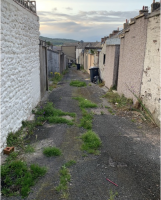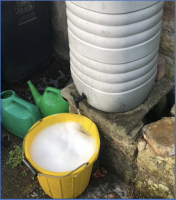Environment Protection document
What Are We Doing?

This is a summary document with hyperlinks to take you to more information.
Environment Protection Guide
January 2024 - District 1190
United Nations world leaders are committed to taking measures to protect the planet, so that it can support the needs of present and future generations. They have identified seventeen global goals that Rotary contributes very significantly to, and we focus here on those aligned to protecting the environment within the direct capabilities of Rotary Clubs, whilst supporting the larger, more industrial endeavours, where possible.
The intent is an easy to read three-page guide, listing key activities with associated reasons, expanded via hyperlinks that take the reader to more information. Those Rotary Clubs having knowledge and experience of a particular activity are invited to offer further refinement of this document and its associated hyperlinks, to assist those wishing to become more involved.
1. INFORMATION and EDUCATION
Information on protecting the environment is becoming increasingly available through local council officers, public libraries, internet focus groups and is also a feature of school curriculums and university courses. Transferring this knowledge, where appropriate, to overseas contacts to assist those less fortunate, has also become a feature for several clubs in our District.
It is considered desirable to have a good background knowledge of all work being undertaken worldwide to be able to inform others, as well as knowing which activities Rotary can undertake either directly or by working with other like-minded groups. Encouraging school children to undertake projects having a visible outcome, with prizes and certificates, perhaps under a Rota Kids banner, always seems to be welcome.
“The Young Environmentalist” competition may also be of interest for those up to the age of seventeen, or for those eighteen and older; a Rotaract Club to exchange ideas with leaders in the community, develop leadership and professional skills, and have fun through service.
2. HABITAT PROTECTION
Habitat protection on land and sea, is a key method of protecting species and the entire food chain, which of course extends to humans and their wellbeing. This is because healthy communities rely on the biodiversity of ecosystems that provide clean air, fresh water, medicines and food.
Pollination
Rotary District 1190, along with other Districts in the UK and overseas, are signing a Pollinator Pledge, in support of “Operation Pollination”. Pollinators include butterflies, bees, some birds, bats, and insects that play a crucial role.
Flower Planting - wild or otherwise
Pleasing to the eye, and especially purple with associated signage, as a reminder of the Rotary Promise to eradicate Polio – with the purple finger being for those having had the vaccination. Signage reminding grass cutters of imminently appearing crocus bulbs, also helps. One may also wish to consider purple sprouting broccoli, heathers, beans with purple pods, herbs and many more, for community gardens.
Growing Food
“Incredible edible” local food is fresher, healthier and tastes better, because it spends less time in transit from farm to plate, loses fewer nutrients and incurs less spoilage, as well as assisting local farmers utilise available land. Further thoughts extend to showing “food miles” on the price tag and on menus in restaurants, highlighting the benefits, to include reducing CO2 emissions of transport.
Litter Picking
A good social activity, the subject area looks better, and it makes everybody feel better.
In particular, the activity serves to remove items hazardous to humans and wildlife.
Gloves and collecting bags can often be obtained from your local town or city council.
Nesting Boxes
Used by small and large birds, including owls, has resulted in a demonstratable increase in the number of nesting pairs. This has been extended to nesting boxes for red squirrels in recent years.
Tidal Marsh Protection
Tidal marshes absorb CO2 from the atmosphere and act as a sediment trap, for which the term “Blue carbon” is often used. Similarly, underwater grasses, which can be destroyed by trawlers dragging the seabed for fish, also sequester carbon. In both cases the effect is greater than CO2 absorption by forests on land. It’s easier in this case, for Rotary to assist by protecting tidal marshes.
Tree Planting
Absorbs CO2, provides oxygen, provides shade and pleasing to look at – as well as being beneficial by protecting riverbanks. Numerous references regarding the right trees in the right area and soil.
Weeding
Removes unwanted plants that compete with beneficial ones. As an example, Himalayan balsam can completely take over riverbanks and dramatically reduce biodiversity, hence “Balsam bashing” has become a very satisfying activity with good social benefits.
3. NEW TECHNOLOGIES
Technological development in recent years is impressive, with support increasing as financial institutions, governing bodies and individuals become more aware of hurdles being overcome to improve the way in which we achieve our objectives. eg plastic eating bugs, bio-char and much more that’s worth knowing about.
4. REDUCE USE OF FOSSIL FUELS
Less CO2 to atmosphere and improves air quality – being achieved with more efficient use of fossil fuels, such as ships at sea using massive spinnaker like sails to reduce the cost of fuel and emissions. Electricity production with efficient gas turbine systems, wind turbines, hydro and gas engines using methane from landfill, being examples. The percentage of electricity via theses “prime movers” may be seen live on GridwatchUK.
CO2 Emission Reduction – Domestic Heating and Electricity
The alternative for mostly domestic consumers, is to use other methods of generating electricity or providing heat, such as solar panels, air or ground source heating that’s effective given good house insulation. In fact, roof mounted solar panels have become more efficient and less obvious, with installation during construction of new build properties being most cost effective.
Solar panels to pre-heat the house water is an option for suitable properties.
More efficient gas boilers and wood burning stoves also reduce the utilisation of fossil fuels, improves human and animal health, as well as reducing CO2 emissions, to the atmosphere, that’s considered to be a major contributor to global warming.
Community buildings can be difficult to modify and insulate, the walls in particular, hence thoughts turn to use of infrared heaters that heat objects, including people, rather than the surrounding air.
A major advantage is that this form of heating can be turned on, just for the period of building use, rather than keeping the property warm 24/7.
CO2 Emission Reduction - Household Water
Drinking water production uses industrial energy and costs money that’s passed on through household bills. There are several ways to use other water sources, such as low energy and less polluting, rain water collection for the garden.
CO2 Emission Reduction - Transport
More efficient motor vehicles and less car miles by reducing the frequency of travel, or mode of low carbon transport - with bicycle stands near bus stops to improve human health as a direct physical exercise benefit. Vehicle EV charging points are on the increase and new build housing often a requirement of the planning permission.
Pollution of Rivers and Lakes - Reduction
Like habitat protection on land, and with more and more species facing extinction, which affects the food chain ofmarine life influencing quite significantly, the foods on which humans rely.
One matter of focus that may be more a matter of lobbying and outside of normal Rotary activities, is the blue green algae (nitrates), which is toxic, kills everything, and is seen more during the dryer months of the year. This often comes from fertilisers washed off fields that may not have been deposited within the best practice rules, but more recently raw sewage discharges, many of which are formally recorded and requiring greater expenditure on sewage treatment plants. It is worth noting the dangers of swimming in these waters.
One project under consideration in the North West, is Rotary assisting a local Rivers Trust group with water sampling, after training and whilst out walking.
4. DISPOSAL
Recycling
“Plastics” feature greatly here, as they take years to decompose and emit toxic substances whilst doing so. Disposal near oceans, rivers and lakes, result in being digested by animals, fish and mammals, not to mention the effect of “micro-plastics” generally. Care with disposal, is undertaken in most households with segregation, and stores assist reduce single use plastic bags as well as accepting used plastic wrappings.
More on a combined effort front, its worth knowing that tablet blister packs can be sent to Terracycle Ltd, given say 1,500 are collected over time, albeit chargeable.
Upcycling
Upcycling comes in many forms. It reduces discarded materials and the need for production of new and use of raw materials, hence less pollution, less cost and satisfying use of DIY skills.
A further thought, is relatively short term use of plastic bottles, which school children can collect especially before being disposed of, to build an Eco-greenhouse, thus lower cost and saving on glass production.
5. Cost
A significant amount of Rotary funds go into achieving much of the foregoing, although there are grants available under several headings, so just a matter of undertaking research on-line or via your local City or County Council.
Disclaimer
All information here and via recommended hyperlinks, has been provided with good intent and best endeavours.
Please share, noting that no responsibility can be accepted for the outcome of any associated use of the said information.
John Blowes MBE PHF - District 1190 Environment Officer e: blowesjohn@gmail.com Issue: January 2024
Environment Protection document sub-pages:

Litter Picking and Weeding
more Working with other groups to keep areas clean and tidy
Related pages...

Litter Picking
more Carnforth Community Primary School

Did You Know?
more A few questions about reducing energy use, Co2 output and waste.
back to page above this...

Environment
back This is the 7th area of focus. Carnforth Rotarian, John Blowes, is District Lead.